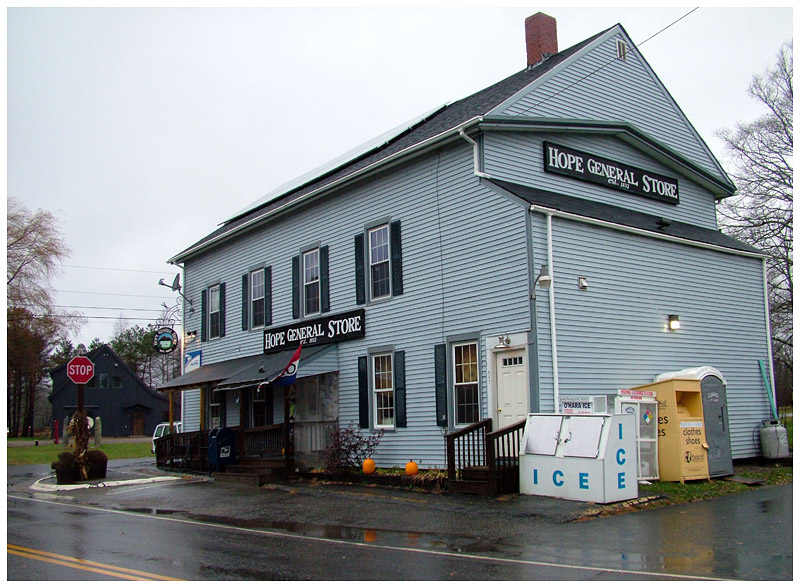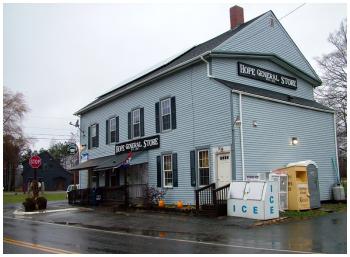I’m sorry, but we’re out of elephants
HOPE - Almost nine years after he opened Hope General Store, Andrew Stewart has put the business on the market in order to pursue his new job as director of Hope Elephants.
When he told his friends and family the news, some of them thought he was crazy. Not only was Stewart the owner of a successful business, but the general store he resurrected from a broken lineage dating to before the Civil War was central in the town’s transformation over the past decade from a sleepy village in decline to a lively upstart community that could claim, without irony, “Hope is Hip.”
The career move may seem like an odd one — Hope is probably the only town of 1,500 where it’s even an option — but conservation is to a large extent about bringing people together, and if Hope General Store is any indication, Stewart’s resume speaks for itself.
“I don’t know if I can take credit for it,” he said, “but having a spot for people to meet their neighbors ... that wasn’t here before. People would wake up and go to Rockland or Camden where they worked, and they’d come back. There was nowhere in Hope where people met anymore.”
Stewart sat at a table in a corner of the store set aside as a kind of cafe. Outside it was raining. Behind him, several groups of regulars jockeyed for one of the larger tables. Occasionally he got up and slipped behind the cash register. Later he would drive to his new office in Camden.
“Everyone comes in and talks about what’s been happening, so I’ve been a part of just about everything. All the kids that are born, and then the other side when people pass away. Someone’s building a house. All those ... “
He paused. “They’re not little things. But I guess in the scale of things they are.”
Stewart met his wife in Hope. The first of their two children was born upstairs from the store. At 37, this would be his first career move with a family.
“It’s been a great nine years,” he said. “I think part of it is, I never really planned to open a store. It just sort of happened.”
Future historical accounts will probably say the same about Hope, the diamond-shaped town with the ceaselessly optimistic name, where not much happened for a very long time.
Topography didn’t help the town. Beneath its straight borders, mountains and water separate the north and south sides of town.
For much of its 210-year history Hope was neither here nor there: a farming hamlet that wasn’t hospitable to farming; a bedroom community to Camden or Rockland, depending upon one’s orientation to Ragged Mountain.
South Hope in recent years benefited from Route 17, a commercial strip running straight into Rockland. By contrast, Hope Village to the north languished as little more than a four-way intersection, 10 miles inland from Camden by the winding rural Route 105.
By the time Stewart came to town, the old general store had been closed for five or six years and the Grange Hall across the street that had long served as a community meeting place was on its way out.
As he recalls, there wasn’t even a place to get a cup of coffee.
His original plan was simply to renovate the old building. It wasn’t until he’d ordered inventory for the store that he realized what he’d signed up for.
“I know that was the obvious conclusion,” he said, “but it didn’t hit home until we opened the doors.”
Stewart’s previous travels didn’t exactly suggest a shopkeeper’s temperament. The Scottish native had been living in Seattle before, as he describes it, he came to Camden to visit his sister and never left.
“Before that I was in London. Before that I was in Botswana,” he said. There were stops in Wyoming and Boston.
But in Hope, Stewart got hooked on the possibilities of a store in a town that had none.
“I wanted it to be a community center more than just a place where you could buy milk,” he said. “I wanted it to have some character, more along the lines of a [traditional] general store than a convenience store.”
He sent out survey postcards to every resident in town and got back around 100 responses. If someone asked for something, he made a point to stock it.
“I used to have customers who would come in and try to catch me out,” he said. “They’d say, ‘Do you have paraffin oil? How ‘bout bar-and-chain oil? Ok, I need a soccer ball. Oh, you have one of those, too.’”
On his own, he built up a stock of 140 types of beer at a time when it was rare to see microbrews outside of the larger coastal cities. He put a kitchen in back corner of the store and a small seating area where people residents could congregate for morning coffee or lunch. He reclaimed the store’s status as an outpost of the Camden post office.
Hope General Store attracted what turned out to be a fairly diverse group of locals, from lifelong Mainers to young professionals who came in with the arrival of MBNA in the mid-’90s and more recent blow-ins like Stewart.
They found their way to the new business in the village center, and once they were there they invariably ran into neighbors. Conversation ensued, and things started to happen in Hope.
The Hope Triathlon, the Children’s Festival, the Fishing Derby, Winterfest and the Hope Jazz Festival all started in the following years. Stewart was directly involved in many of these events, and those that he wasn’t behind often originated with conversations at the general store.
For a number of years, local fire engine restorer Andy Swift hosted an annual community party with live music. On one of those occasions, in 2005 or 2006, Stewart looked out the window of the store and saw a huge group of people dancing to the music.
“One of the guys shouted out, ‘I never realized Hope was so hip!’ So we stuck it on a bumper sticker,” Stewart said.
The store sold somewhere between two and three thousand of them — close to two stickers per resident of Hope.
“I remember I went down to Fenway one time to watch the Red Sox, and I watched a car just drive by and it had the bumper sticker on the back,” he said. “That was pretty cool.”
A number of new business opened within a stone’s throw of the central intersection in Hope Village. In the spirit of the general store (and a blacksmith across the street who predated Stewart’s arrival) many of the new entrepreneurs plied trades that invoked the simplicity of a bygone era: a carpentery shop, a spinnery, a cobbler, a bagpipe maker.
The Camden-based conservancy Coastal Mountains Land Trust opened th 27-acre Hatchet Mountain Preserve in 2007 adding to the list of attractions in Hope. And last year, Sweet Tree Arts opened across the street from Hope General Store. The town saw upgrades to municipal buildings like the town office and fire station.
The arrival of Hope Elephants last year underscored what had been, until that point, a modest small town revival.
The rehabilitation facility and education center opened by Jim and Tom Laurita in 2012 is currently home to a pair of Asian elephants, Rosie and Opal, both retired circus performers.
Stewart first learned of the project almost a decade ago, after his dog had a run in with a porcupine. Jim Laurita was the local veterinarian.
“He had a big picture of an elephant on the wall and we started talking elephants,” Stewart said.
In a past life, Stewart worked as a safari guide in Botswana’s Kalahari region. He had seen elephants as part of his day-to-day work, and knew what they were up against.
Laurita told Stewart about his plans for a rehabilitation center.
“I said, oh yeah, let me know if that ever happens. I’ll help you out,” Stewart said.
Hope Elephants did happen. The facility opened last year to much fanfare and some controversy. Stewart signed on at the start as an assistant handler — one of three people who would work directly with the elephants. When he was offered the director’s position, he took it.
“I feel closer to [Hope Elephants] because my background is in animal biology,” he said. “That was my original life plan to be more involved in that sort of area.”
Hope Elephants is unique in the Northeastern United States and probably in a much wider area. 17,000 people visited in first year including many school groups. Initially, Stewart said the organization has been focused on rehabilitating Rosie and Opal and pioneering new techniques for use with retired circus elephants.
A year in, Stewart said, the organization is expanding its mission in hopes of heading off extinction for wild elephants, which he said matter-of-factly could happen as soon as 2020 or 2025.
The fate of elephants, he said, is essentially linked to human economies. Wealthy countries continue to have an appetite for ivory, and in “range countries” where elephants live, there aren’t enough ways to make a living for residents to turn their backs on what amounts to a natural resource. Rather than trying to catch poachers, Stewart said it makes more sense to go to the root of the problem.
“If you put a value on something, then someone’s going to try to make money from it,” he said.
Stewart talked easily what happens when human and elephant populations come into conflict, the genetic probabilities that leave small populations of species more susceptible to sudden extinction, the supposed impossibility of changing high-end Asian markets — he points out that consumption of shark’s fin soup — a traditional display of wealth — was cut dramatically through education.
“It’s similar with ivory,” he said. “It’s a status symbol, nothing else.”
The benefit of a facility like Hope Elephants is that it keeps the animals, and their tusks, in plain view. By next spring, Stewart said, the hope is to expand that visibility to students in Hong Kong and Tanzania using the online video chat service Skype.
“The second you try to take [elephants] out of the spotlight and move them away, that’s when the funding dries up and conservation opportunities dry up and we really will see the extinction of what is one of the icons of the natural world,” he said. “So ...”
The word hung there as the voices from a group of people at a nearby table filled the space.
It was a conversation that might not have happened 10 years ago.
Ethan Andrews can be reached at news@penbaypilot.com
Event Date
Address
449 Camden Road
Hope, ME 04847
United States
































